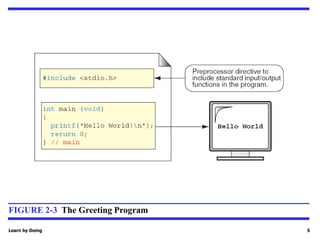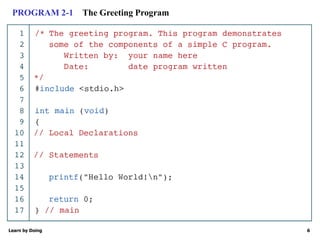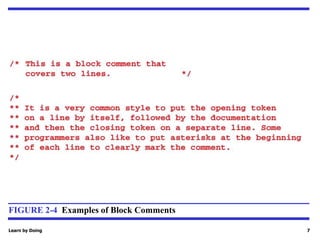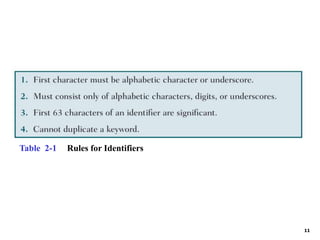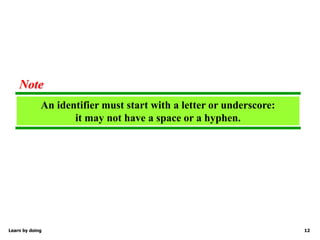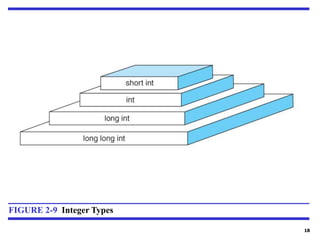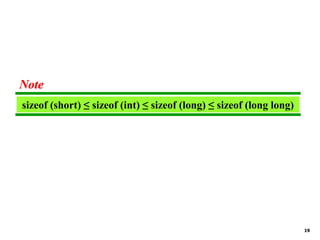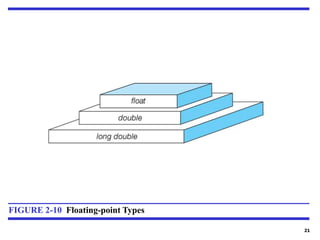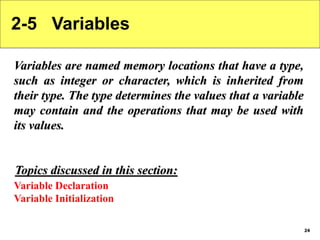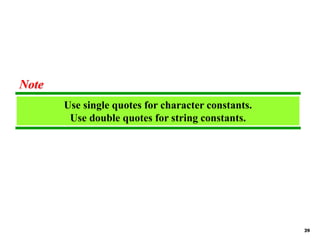CODING-DAY-2-INTRODUCTION TO C PROGRAMMING.ppt
- 1. Learn by Doing 1 Objectives ❏ To understand the structure of a C-language program. ❏ To write your first C program. ❏ To introduce the include preprocessor command. ❏ To be able to create good identifiers for objects in a program. ❏ To be able to list, describe, and use the C basic data types. ❏ To be able to create and use variables and constants. ❏ To understand input and output concepts. ❏ To be able to use simple input and output statements. Day 2 Introduction to the C Language
- 2. Learn by Doing 2 2-1 Background C is a structured programming language. It is considered a high-level language because it allows the programmer to concentrate on the problem at hand and not worry about the machine that the program will be using. That is another reason why it is used by software developers whose applications have to run on many different hardware platforms.
- 3. Learn by Doing 3 2-2 C Programs It's time to write your first C program. Structure of a C Program Your First C Program Comments The Greeting Program Topics discussed in this section:
- 4. Learn by Doing 4 FIGURE 2-2 Structure of a C Program
- 5. Learn by Doing 5 FIGURE 2-3 The Greeting Program
- 6. Learn by Doing 6 PROGRAM 2-1 The Greeting Program
- 7. Learn by Doing 7 FIGURE 2-4 Examples of Block Comments
- 8. Learn by Doing 8 FIGURE 2-5 Examples of Line Comments
- 9. 9 FIGURE 2-6 Nested Block Comments Are Invalid
- 10. 10 2-3 Identifiers One feature present in all computer languages is the identifier. Identifiers allow us to name data and other objects in the program. Each identified object in the computer is stored at a unique address.
- 11. 11 Table 2-1 Rules for Identifiers
- 12. Learn by doing 12 An identifier must start with a letter or underscore: it may not have a space or a hyphen. Note
- 13. 13 C is a case-sensitive language. Note
- 14. 14 Table 2-2 Examples of Valid and Invalid Names
- 15. Learn by doing 15 2-4 Types A type defines a set of values and a set of operations that can be applied on those values. Void Type Integral Type Floating-Point Types Topics discussed in this section:
- 16. 16 FIGURE 2-7 Data Types
- 17. 17 FIGURE 2-8 Character Types
- 18. 18 FIGURE 2-9 Integer Types
- 19. 19 sizeof (short) ≤ sizeof (int) ≤ sizeof (long) ≤ sizeof (long long) Note
- 20. 20 Table 2-3 Typical Integer Sizes and Values for Signed Integers
- 21. 21 FIGURE 2-10 Floating-point Types
- 22. Learn by doing 22 sizeof (float) ≤ sizeof (double) ≤ sizeof (long double) Note
- 23. 23 Table 2-4 Type Summary
- 24. 24 2-5 Variables Variables are named memory locations that have a type, such as integer or character, which is inherited from their type. The type determines the values that a variable may contain and the operations that may be used with its values. Variable Declaration Variable Initialization Topics discussed in this section:
- 26. 26 Table 2-5 Examples of Variable Declarations and Definitions
- 27. 27 FIGURE 2-12 Variable Initialization ‘B’
- 28. 28 When a variable is defined, it is not initialized. We must initialize any variable requiring prescribed data when the function starts. Note
- 29. Learn by doing 29 PROGRAM 2-2 Print Sum of Three Numbers
- 30. 30 PROGRAM 2-2 Print Sum of Three Numbers (continued)
- 31. 31 PROGRAM 2-2 Print Sum of Three Numbers (continued)
- 32. 32 2-6 Constants Constants are data values that cannot be changed during the execution of a program. Like variables, constants have a type. In this section, we discuss Boolean, character, integer, real, complex, and string constants. Constant Representation Coding Constants Topics discussed in this section:
- 33. 33 A character constant is enclosed in single quotes. Note
- 34. Learn by doing 34 Table 2-6 Symbolic Names for Control Characters
- 35. 35 Table 2-7 Examples of Integer Constants
- 36. 36 Table 2-8 Examples of Real Constants
- 37. 37 FIGURE 2-13 Some Strings
- 38. Learn by doing 38 FIGURE 2-14 Null Characters and Null Strings
- 39. 39 Use single quotes for character constants. Use double quotes for string constants. Note
- 40. 40 PROGRAM 2-3 Memory Constants
- 41. Learn by doing 41 PROGRAM 2-3 Memory Constants (continued)




